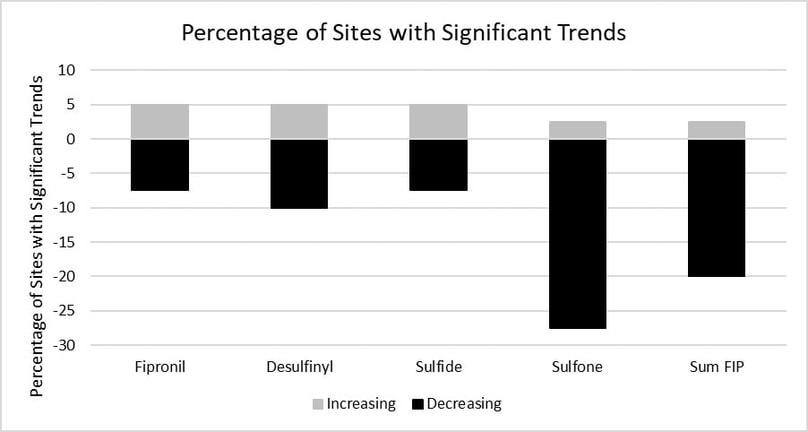The phenylpyrazole fipronil is a current-use insecticide approved for urban use in California. The primary outdoor use for fipronil is structural pest control which includes outdoor spraying around buildings to control nuisance insects such as ants. Other structural pest control applications, primarily for termite control, include underground injection (into soil around foundations) and indoors in non-occupied foundation spaces (e.g., a dust injected into building wood). Fipronil is also well-known as the active ingredient in anti-flea and tick topical pet applications. Use of fipronil has been steadily increasing since its introduction in 1996 (Simon-Delso et al. 2015). This pesticide and its degradates are of ecological concern in California watersheds because of toxicity to stream insects, particularly chironomids (Weston and Lydy 2014).
Trends were calculated for the fipronil parent compound, three metabolites, and the sum of the compounds using data from 2013 to 2022. Fipronil and its degradates were measured at 40 sites with high urban land use, but correlation analysis was conducted between median site concentrations and agricultural and urban land use.
There was a relatively high incidence of fipronil detection in urban sediments, particularly of the fipronil sulfide and sulfone degradates, which are more toxic than the parent compound (Weston and Lydy, 2014). Statewide, trends in concentrations of the parent compound and the sum of fipronil showed no trend. Conversely, the degradates fipronil desulfinyl and fipronil sulfide show a significant increase, and fipronil sulfone shows a significant decrease. Throughout the state, more sites are showing significant decreases in fipronil and its metabolites. Interestingly, median concentrations of fipronil and its degradates from individual sites did not significantly correlate with land use.
References
Trends were calculated for the fipronil parent compound, three metabolites, and the sum of the compounds using data from 2013 to 2022. Fipronil and its degradates were measured at 40 sites with high urban land use, but correlation analysis was conducted between median site concentrations and agricultural and urban land use.
There was a relatively high incidence of fipronil detection in urban sediments, particularly of the fipronil sulfide and sulfone degradates, which are more toxic than the parent compound (Weston and Lydy, 2014). Statewide, trends in concentrations of the parent compound and the sum of fipronil showed no trend. Conversely, the degradates fipronil desulfinyl and fipronil sulfide show a significant increase, and fipronil sulfone shows a significant decrease. Throughout the state, more sites are showing significant decreases in fipronil and its metabolites. Interestingly, median concentrations of fipronil and its degradates from individual sites did not significantly correlate with land use.
References
- Simon-Delso N, Amaral-Rogers V, Belzunces LP, Bonmatin JM, Chagnon M, Downs C, Furlan L, Gibbons DW, Giorio C, Girolami V et al. . 2015. Systemic insecticides (neonicotinoids and fipronil): trends, uses, mode of action and metabolites. Environmental Science and Pollution Research International 22(1):5-34.
- Weston DP, Lydy MJ. 2014. Toxicity of the Insecticide Fipronil and Its Degradates to Benthic Macroinvertebrates of Urban Streams. Environ Sci Technol 48:1290-1297.

